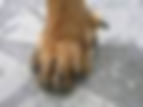Is It a Briard?
We are a group of animal lovers dedicated to rescuing Briard dogs. We love all dogs and animals in general, but by focusing on one breed we have a better chance of connecting these dogs to the proper care and resources that they need and financially assist their transportation to new homes for these wonderful pets. So how do you know if you have a Briard?
Basic Characteristics
The Briard was bred to be a full-service shepherding dog. Where some herding-only dogs are smaller and more agile, and some guarding dogs are larger and more rugged, the Briard is in the middle to accomplish both tasks in one highly functional and highly efficient package.
Size
Dog height is measure at the “withers.” The withers is the highest spot between the shoulder blades of the front legs. Male Briards stand 24 to 27 inches at the withers, and female Briards are often 23 to 26 inches at the withers. Size Matters.
Coat and Color
Briards come in three colors: Tawny, Black, and Gray. Tawny is a color similar to caramel with occasional black highlights. Gray is less common, and gray Briards are usually black as puppies–taking on their distinctive gray color as mature adult dogs.
In a healthy dog, the natural state of the Briard coat is long and wavy. If you grab a strand from the flank, it could be 5 to 8 inches long or more. If you look closely, you might see that the coat is actually comprised of an outer layer of longer hairs that are more coarse and an inner, insulating layer that is shorter and a bit softer closer to the skin.
Because the outer hair is so long, some people trim it short–especially in warmer climates. This can make a dog harder to identify.
Face
A Briard’s nose is square-ish (rather than round or triangle) and is very dark. Their eyes are dark as well, being brown to almost black, and there is dark skin around the eyes–almost as if the dog is wearing eye-liner.
Briards may have cropped ears that point up, or non-cropped ears that lay down. In Europe, most dogs have natural, non-cropped ears. In the US, it is common to see both styles.
Six Toes?
One of the more unique attributes of the Briard is that they have extra toes on their rear feet. These help them maneuver quickly in the grass when herding sheep. These extra toes are called “dew claws” and although may dogs have them, most only have one dew claw, where the Briard has two.
And the Briard is unique in that it’s dew claws are functional and “on the ground,” where other breeds have the dew claw often above the ground on the back of the leg. This means that a Briard “footprint” may show six toes. Sometimes the claw itself may break off of the toe.
If the hair is long, it may be difficult to see the dew claws, but you should be able to “feel” them through the fur.

Do Not Be Confused
Many people confuse the Wheaten Terrier for a Briard. This is understandable since the Wheaten can look like a Briard to the untrained eye, but it is much smaller, usually standing only about 17 to 20 inches at the withers when fully grown. And even though Wheaten puppies can be many colors, adult Wheatens are usually a lighter, creamy color (as opposed to the tawny or black color of Briards) and have a softer outer coat.
If you think that you have a Wheaten Terrier that needs rescuing, consider contacting the people at Wheaten Terrier Rescue for assistance.
Another mix-up comes when there is a Chow or Chow mix involved. These are usually identified by their black tongues and prick ear. The crop ear on a Briard has a scar on the outside edge with no hair.
Still Need More Help?
If you have a dog that needs to be rescued and you are still not sure if it is a Briard, send us photo via email to the address on our Get Help Now page and we will do our best to help.



*Important Disclaimer: Briard Rescue Trust (BRT) creates content and also curates content created by others. All content and resources created by us–including this website–are the property and copyright of BRT. However, all content and resources created by others are the property and copyright of the respective owners, even if the BRT is hosting, referencing, or linking to that content on our website. This is called “third-party content” and BRT references and / or displays it under “fair use” for non-profit and educational purposes. BRT displays all content as a free service “as is” and BRT is not responsible for the accuracy of any content or its applicability to any situation or set of circumstances. We always recommend that users and visitors perform their own due diligence by consulting with additional resources, a professional veterinarian, and / or other certified animal care professional before making an informed decision or implementing any instruction or procedure.